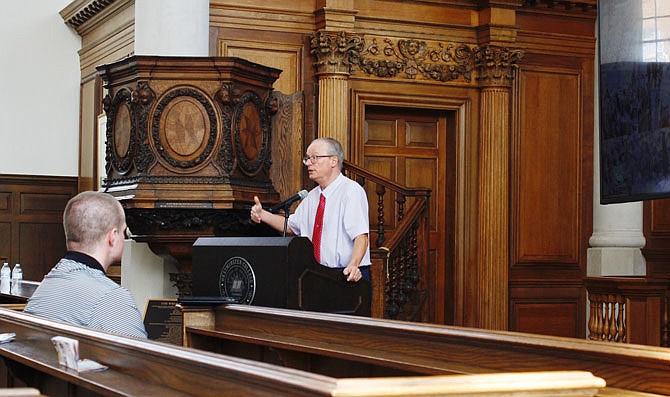James Hansen, biographer of Neil Armstrong, spoke at Westminster College on Wednesday to preview his new book coming in October.
As a part of the 14th Hancock Symposium, Hansen's talk revolved around his forthcoming book "Dear Neil Armstrong: Letters to the First Man from All Mankind," which will be available Oct. 15. The book is a collection of letters and correspondence between Neil Armstrong and his fans, even critics, from all over the globe.
"An overwhelming sense that I got after reading through all of this was, 'Please leave this guy alone,'" Hansen said.
Hansen had the fortune of spending time with Armstrong in his later life while writing Armstrong's biography "First Man," which became a major motion picture in 2018. Hansen explained how it took two years of convincing to get the green light from Armstrong to be able to pen his biography.
"I wrote him a letter; he wrote me back a short, polite letter that basically said, 'not right now," Hansen said. "I backed off for a little bit and I sent him a gift box with three of my books for his 70th birthday. A few months later, I got a letter saying 'let's keep the door open to future possibilities.' Long story short, that opened the door to him inviting me to his home."
Hansen spent the past summers at Armstrong's alma mater, Purdue University, going through the collection of about 75,000 letters to Armstrong the university holds in archives. Hansen said the bulk of Armstrong's letters were discarded by NASA because they took up too much space.
"To me and other historians, we're devastated by the loss of these letters. But I guess I'm in pretty decent shape already having so many to choose from," he said.
Hansen said, from 1969-70, Armstrong received 10,000 letters per week. Hansen said Armstrong tried his hardest to reply to the kind letters throughout his life while the not-so-kind ones were usually met with form letters. While compiling letters for the book, Hansen said he came to the realization he was not making a biography, but an iconography.
"I was studying a symbol. I was studying what society and culture projected onto Armstrong," he said. "The astronaut is always at the center of any visual presentation promoting the space program."
Hansen also covered the history of the international space race and touched on events like the Russian satellite Sputnik and the American "Mercury Seven." He explained the historical significance of the space race and how it shaped world history.
"If Sputnik did not come first, Nixon would have been elected (in 1960) and would not have launched the space program like Kennedy did, and we probably would have not made putting a man on the moon a priority," Hansen said.
He emphasized how after the moon landing, the American astronauts were going to countries all across the world being greeted by crowds of hundreds of thousands of people -sometimes millions - and everybody was cheering and proud of them.
"(The astronauts) expected the people to say, 'Good job, Americans.' But what they heard was, 'We did it! We, humankind, did it!'" Hansen said. "And this is one of those unifying experiences that I don't think we've had since, and it's hard to imagine anything like it happening today."

